Translation Issues (2) - under
construction!
add rest of alternative translation examples, Cora!
Keiji
Oto
Discussion Paper #1
Humanities 210
Asian Poetry in Translation
[According to one source,] the Asian poetry may differ from the Western poetry in at least three ways: (1) in the use of forms employed in the West, and in the presence or absence of approximation of Western forms, such as the long narrative poem and dramatic poetry; (2) in its preference for certain kinds of metaphors and symbols; and (3) in its use or nonuse of prosodic devices that the particular language favors or discourages because of its structure, including rhyme.
A good translation needs some preconditions why translators elect to translate a poem, reasons that have to do with respect and value, and they also must have a deep sense of recognition and self-knowledge confirmed by the poems. It is essential for [translators] to read, interpret, and feel the poems, and if they really achieve these sequences, you can become creatively involved in the poem in your own way.
Personally, I understand the fundamental Chinese character, so let me translate Li Po's "Drinking Alone under the Moon," and then i think you will not have any difficulties noticing that I am a good example of a bad translator.
Between the
flowers, there is a sake.
I drink it; there is no friend or parent.
I raise a cup, and invite cheerful moon.
My shadow makes three people.
The problem with this translation may be the unclearness. I didn't interpret or feel the original poem fully, so you didn't probably find the strong loneliness which hidden under the surface.
Haiku is a poetic form unique to Japan, and is the shortest poetic form in the world. It is said that the haiku form was created in the 17th century and flourished in the Edo period when master poet such as Basho emerged on the scene. Haiku are composed of words accommodating a three-line, 5-7-5 Japanese syllabic structure. For example:
Furuikeya
kaxazu tobikomu
mizu no oto
Here is a translation of this haiku:
An old pond
A frog jumps in
sound of the water.
A basic rule holds that haiku must contain a kigo, or a word that expresses the season. In the above haiku, the frog is the seasonal word.
Waka is another poetic form perfected in the beginning of the 7th century. Its original form can be seen in the Manyoshu, an anthology of poems compiled in the 8th century. Words which express the poet's feeling or the seasonal conditions are set into a 5-7-5-7-7 syllabic structure. Without seasonal words as required in haiku, waka allows more freedom of subject matter.
Tokai
no
kojima no iso no
shirasuna ni
ware nakinurete
kani to tawamuru.
Here is a translation of this waka:
On the
white sand of a rocky beach
on a small island
off the Tokai coast
Soaked in tears
I play with a crab.
This is a famous poem by Takuboku Ishikawa. if you read it aloud, you will hear the 5-7-5-7-7 rhythm. The pleasing resonance of its words is one of the reasons why the Japanese have long cherished the waka.
Thus, the poem's content is comprehensible. There is no single word which, taken by itself, would be unfamiliar or unclear, but I don't think the poet offer those comprehensions to us. This may make you confused; in my opinion, poetry is neither expression nor creation of people, for poetry speaks its own voice. So, what could you listen to? Did my translation speak anything to you?
© Keiji Oto, 1998
![]()
Izumi
Ota
Dialogue #3
Humanities 210 (Spring 1998)
CHINESE TRANSLATION ISSUES
. . . . From my translation experience, I can tell you some things. I do not really know Chinese character very well, but because Chinese and Japanese characters are similar, I can tell you some of the difficulty when we translate from English into Chinese. . . . English . . . alphabet . . . has only 26 characters, but Chinese . . . has more than thousand of characters. Chinese is more like Japanese. In English, each [letter of the] alphabet does not have a specific meaning, but in Chinese each character has [a] different meaning and we can make [an] easy sentence with two or three characters. For example:
| For example: |  |
../asianimages/Ota1.jpg
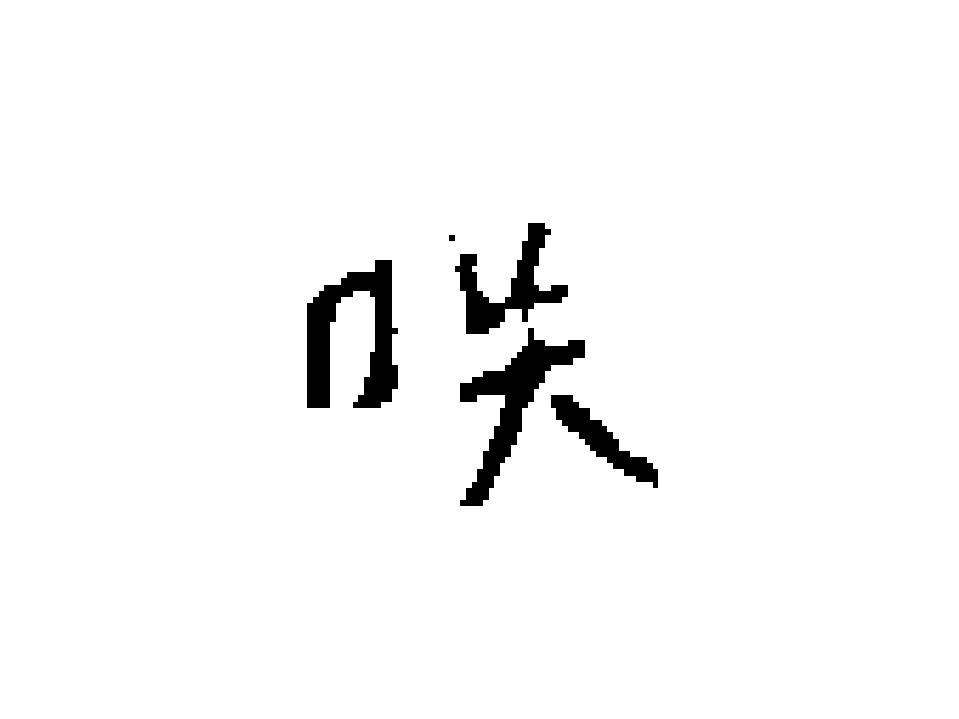 |
is one character, and |
 |
is one character. |
../asianimages/Ota2b.jpg
../asianimages/Ota3b.jpg
When I put these two together, it means, "The flower is blooming." [But i]n English, I [must] use 19 letters to explain these two Chinese characters.
Dialogue #3
Humanities 210 (Spring 1998)
CHINESE TRANSLATION ISSUES
It is said that Kanji was brought to Japan from China around the first century AD [or CE]. However, Japanese use only a few thousands of Chinese characters which are not that old....So if it's written in easy kind of Chinese character, we can "guess" what it's said, as when I was looking for a bathroom in China: I saw three Chinese characters which mean "water," "wash," and "place"; then I assumed it must be the restroom. Chinese characters are pictographs symbolizing physical objects; each character has meaning:
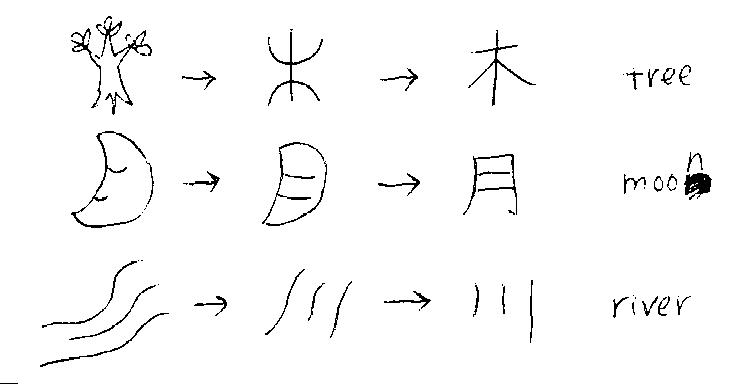 |
|
.../hum210/asianimages/kanai1.jpg |
Two or more elements, each having its own meaning, form a character:
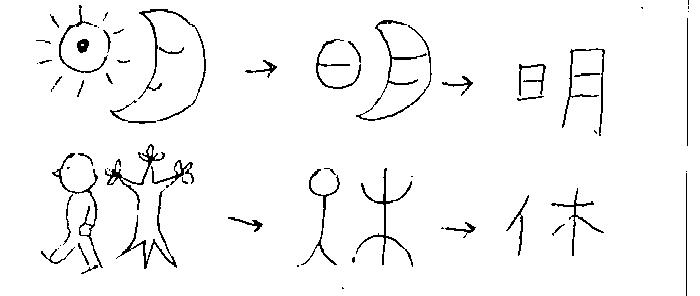 |
bright (sun + moon) |
| relax (person + tree) |
.../hum210/asianimages/kanai2.jpg
Therefore, the advantage of Chinese characters is that you can often associate the meaning of the character with the shape of it, even if you don't know the pronunciation.
|
Two Translations of Mao or Song
#76 from Shi Jing (or Shih Ching) |
|
| [Cora's Note:] Shi Jing is an ancient collection of oral song-poems, originally accompanied by music, dating from c. 12th - 7th B.C.E. of the Zhou (or Chou) Dynasty era of early Chinese pre-history. Tradition credits Confucius (551-479 B.C.E.) with compiling and writing down 305 of these ancient songs. The anthology Shi Jing is one of the five Confucian "Classic" books and has had a enormous influence in shaping Chinese literary history, its poetic tradition, themes, and forms. The other Classics are The Book of Changes [I Ching], The Classic of History, The Spring and Autumn Annals, and The Book of Rites. The now-lost Classic of Music is sometimes included as the sixth Classic. The Shi Jing became a basic text of Chinese education; an educated person was expected to have memorized these songs, which the sage Confucius held in high respect for their moral and ethical significance. | |
| "Secret Courtship" [Song #76] Trans. Arthur Waley |
Mao #76 Trans. Liu Wu-Chi |
| I beg of you, Chung Tzu, | I beg you, Chung-tzu, |
| Do not climb into our homestead, | Do not leap into my homestead; |
| Do not break the willows we have planted. | Do not break my willow trees! |
| Not that I mind about the willows, | Not that I care about them, |
| But I am afraid of my father and mother. | But I am afraid of my parents. |
| Chung Tzu I dearly love; | Chung I dearly love, |
| But of what my father and mother say | But of my parents' words, |
| Indeed I am afraid. | Indeed I am afraid. |
| I beg of you, Chung Tzu, | I beg you, Chung-tzu, |
| Do not climb over our wall, | Do not leap over my wall; |
| Do not break the mulberry-trees we have planted. | Do not break my mulberry trees! |
| Not that I mind about the mulberry-trees, | Not that I care about them, |
| But I am afraid of my brothers. | But I am afraid of my elder brothers. |
| Chung Tzu I dearly love; | Chung I dearly love, |
| But of what my brothers say | But of my brothers' words, |
| Indeed I am afraid. | Indeed I am afraid. |
| I beg of you, Chung Tzu, | I beg you, Chung-tzu, |
| Do not climb into our garden, | Do not leap into my garden; |
| Do not break the hard-wood we have planted. | Do not break my sandalwood trees! |
| Not that I mind about the hard-wood, | Not that I care about them, |
| But I am afraid of what people will say. | But I am afraid of people's gossip. |
| Chung Tzu I dearly love; | Chung I dearly love, |
| But of all that people will say | But of people's gossip, |
| Indeed I am afraid. | Indeed I am afraid. |
| Note on Song #76: The rural lover in China frequently visited his lady at night. He was expected to display his courage and resourcefulness by cleverly and quietly overcoming all obstacles in reaching her side. Although sometimes difficult, he was obligated to leave her home by daylight. | |
In a poem "Secret Courtship," I don't see any big differences between two translations [see above, given in class handout]. The word "leap into" might be a little awkward for English speakers. But I think the original Chinese character for "to leap into" is also translated as "to climb over" depending on the situation, since one Chinese character has usually more than two meanings, or at least two ways to translate. The word "care" seems to me the same as "mind." The word "words" is exactly "what they say." If I were a native English speaker, I might feel it a little strange if it didn't sound right to me, but I think a bit of awkwardness makes foreign poems even more exotic and we would enjoy it. So I would prefer reading foreign poems with the translation by a native speaker of that language first, and enjoy their word choice or way of expression. Then I'd read the one by an English speaker later if I didn't quite understand the first one. Actually, examining the differences is interesting too.
© Mayumi Kanai, 1998
![]()
Mayumi Kanai
Dialogue #4
Hum 210 (Spring 1998)
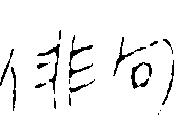 |
.../hum210/asianimages/haiku.jpg
Haiku
Sunflower
peeping at the glaring sun
over the fence.
Summer has come, but sunflowers are not quite grown yet--not as tall as fences. They are in a hurry to become taller so they can enjoy 100% of the sun of summer.
Seasonal word is "sunflower" = summer. But this should be early summer because of the restlessness of the flowers.
I'm not sure how we do 5-7-5 in English. This method seems to be impossible in English. Besides, haiku is very short and grammar is often fragmentary.
The Japanese order of thought often is the exact opposite of English. In English [i.e. in Japanese] I would put the word "sunflower" in the last. I think Japanese tend to say what they want to say most in the last. They often take up the main issue after a few introductory issues. That might result in not telling their honest feelings first, and later it gets harder to say "no." I've heard that Japanese people don't say "No" clearly. I must admit it....
© Mayumi Kanai, 1998
![]()
![]() Nobuhisa Kondo
Nobuhisa Kondo
Dialogue #4
Hum 210 (Spring 1998)
Haiku
In Japanese:
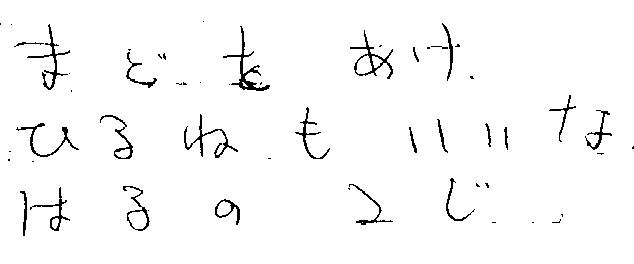 |
5 |
| 7 | |
| 5 |
../asianimages/Kondo1.jpg
--to pronounce:
| Ma do wo A ke |
| Hirune mo i-i -na |
| Haru no ni-j-i |
--translated into English:
| Open the window |
| Taking a nap is good, too. |
| A spring day, 2:00 p.m. |
I wrote this haiku in Japanese first, and translated into [English]..., so it might not make sense in English if my translation was not very good. Anyway, I like to take nap, and a spring day is a better time to take a nap. That's why I made this haiku. Open your bedroom window and take a nap at 2 p.m. on a spring day. I mean, there are lots of other things to do on a spring day, like playing soccer or going to swim....but taking a nap is good. That's why I put "too" in the second line of this haiku. I tried to use "kigo," a seasonal word, and "spring" is that, as you know.
© Nobuhisa Kondo, 1998
Izumi
Ota2
Dialogue #4
Hum 210 (Spring 1998)
Haiku
I created this haiku:
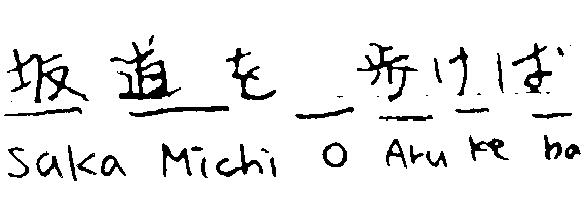 |
 |
../asianimages/Izu1.jpg
../asianimages/Izu2.jpg
When I walk up to the hill, I can see the spring haze. I usually come to COCC by driving, but one morning, I had a chance to come to COCC by walking from my friend's house, because I spent a night in her house and I had no car. It is very hard and made me tired to go up to the hill, which I have to pass to go to COCC. It takes 10-15 minutes to get to my classroom. While I was walking, as it was very early morning and it was very cold, I could see the haze. The haze was very beautiful for me. Also, I smelled spring when I saw the haze. It was cold but I felt that spring is carried by spring wind with beautiful haze. Usually, I don't like the haze because I can't see clearly when I drive. I usually come to school and [so] I missed a lot of beautiful things. I found beautiful spring by walking up to the COCC hill.
Making haiku is not very hard for me. I have learned making and learning haiku for 4 years when I was in Japan. I guess making haiku in English is hard because English is pretty different than Japanese haiku. English haiku does not make any sense for me....In my haiku, "kigo" is "haru Gasumi," which is "spring haze." When you hear my haiku in English, you might think it's quite simple and sounds not very interesting but when Japanese people hear it, they think it sounds interesting. I wish you were Japanese and you could have a nice moment with my Haiku...that's too bad....Japanese and American have quite different taste of haiku....so....
© Izumi Ota, 1998
![]()
Keiji
Oto
Dialogue #4
Hum 210 (Spring 1998)
Haiku
A spring breeze
take me to the
full of dream
I got a rise to this haiku when I came to college by bike in one warm morning. There are several cherry blossoms on my way to college, and I was fascinated by the fall of petals. That view was a little sad, but on the other hand, made me think where those petals could go.
No reason
having hair cut
a spring wind
Being released
quick caught by
a floral melody
A pancake
too much water
thin like me
--by Keiji Oto
© Keiji Oto, 1998
Mayumi
Kanai
Discussion Paper #1
Humanities 210
Asian Poetry in Translation
As Robert Frost said, "poetry is what gets lost in translation," especially when it's translated into English from Chinese or Japanese, which have very different sound structures, grammatical features, and systems of writing. Depending on the translation, preserving the integrity of the structure, form, rhythms, and music of a poem, or capturing the literal meaning of the words, a poem can be slightly different and you'll find what may be lost by comparing two translations.
Because of the absence of tenses, of personal pronouns and of connectives, Chinese poetry may vary interpretations. It is no wonder that critics and annotators have differed as to the meaning of poems in Chinese. Also, for readers in English, sometimes it is better to eliminate or use only seldom the names of places which are familiar in the Occident. However, the places which come up to poems have special spiritual climate which is very significant to the poems. Therefore, the translator would have to try hard to convey the significance to non-native readers, while too much explanation can take the pleasure out of poetry. Also the translator avoids phraseology which, natural and familiar in Chinese, would be exotic or quaint in English. To appreciate the masterpieces of human and universal qualities they [Chinese] endured in their lives, this might be a good idea to read poems in two or more translations with a wide range of interpretation.
As Arthur Waley remarked, "of all poetry Japanese poetry is the most untranslatable." An ideal translation is expected to reproduce the effect of the original in Japanese poetry. However, there are certain particularities about Japanese which make absolute literalness practically impossible. For example, there are no articles in the Japanese language, no pronouns, and no distinctions between singular and plural. This compactness helps Haiku rhyth[m]. In Haiku there is no punctuation, so it's often taken place [instead] by cutting the last words to indicate an unfinished sentence and to make an elusive force...which have no translatable meaning. Also the Japanese language is constructed differently from English. This could give a translator the dilemma of whether to follow the strict grammatical form or the order of thought, or sometimes to supply more important words which are implied but no expressed in the original. This [practice] can be very helpful to understand the sense clearly if the translations are not much too long.
I have found that some poems are over interpreted or lack explanation in translation. For instance, in "One Hundred Poems from One Hundred Poets," which were selected in the third decade of the thirteenth century, there is a poem by the Priest Ryousen.
Sabishisa ni yado wo tachidete nagamureba
izuko mo onaji aki no yuugure
The Japanese order is literally:
sad, lodge, get out, view
wherever, same, autumn, twilight
Translated in "One Hundred Poems from One Hundred Poets," by H. H. Honda (1956):
Sad, I wandered out, and weary,
To soothe my mind, but everywhere
Did I see the shadows dreary
of autumn twilight in the air
As far as I remember what I learned in school, this poem was written when he [Ryousen] was living with strict discipline to become a priest away from home and...he was homesick. He was sad with everything different from his hometown which he was not able to adjust himself to, but he found one same thing which reminded him of his home: the beautiful twilight. The English translation doesn't mention about the word "same."
Here is another example:
Hito wa isa kokoro mo shirazu furusato wa
hana zo mukashi no ka ni nioi keruby Kino Tsurayuki
Literally translated into Japanese:
people, what they are thinking, unknown, my home,
flowers, years ago, fragrance, smell
Into English [also H. H. Hondo??]:
How the village friend may meet me
I know not, but the old plum flowers
Still now their fragrance greet me
kindly as in the bygone hours
Kino, I don't recall why, had to leave his town for some reason. When he was coming back after years, he had kind of a guilty conscience and he was very nervous wondering what the village people would think of him. It had been years and people would have changed. However, he was glad to know that the flowers smelled the same and he felt he was heartily welcomed. I can't tell his anxiety and the probability of coolness of village people in the English translation quite well. Also I wonder why "plum" came up in the English translation. Was clarifying the kind of flowers that important in this poem?
It must be not that easy to find passable English equivalents; however, I've found a nice poem with agreeable English translation in this book (Hondo, 1956).
Sewo hayami iwa ni sekaruru takigawa no
warete mo sue ni awan tozo omouby The Retired Emperor Sutoku
Literally:
stream, rapid, rocks, rush, river water
apart, eventually, meet, I believe
In English:
As water of a stream will meet,
Though, barred by rocks, apart it fall
In rash cascades, so we too, sweet,
Shall be together after all.
Reading it in Japanese, I got an idea that even though they are apart now, they will eventually get together again as water of a stream. Though Haiku are very short, and their grammar is often fragmentary, I enjoy the word choice, order, and rhythm in this English translation. This is very pleasant to find myself becoming suddenly aware of the particular voices of a few poets among the English translation books.
© Mayumi Kanai, 1998
![]()
Nobuhisa
Kondo
Discussion Paper #1
Humanities 210
Relationship Between Zen Buddhism and Art in Japan
Lots of Asian religions are different from what Western people think [of] as a religion, belief in god. Actually, god is not so big deal in those Asian religions: those Asian religions are defined in the [Hum 210] course pack as "ways of liberation to describe these forms of spiritual experience, for all are concerned with liberating human consciousness from ideas and feelings brought about by social conditioning" (p. 219). In other words, those religions try to lead people to the beyond of the world which we perceive only through our senses. One of those Asian religions, the ways of liberation, is Buddhism.
Buddhism was created by one of those Indian countries' princes Gautama Buddha and was developed by his students in the Mahayana school, one of those Buddhist schools. Shortly, Buddha and his students tried to correct the misunderstanding of liberation; people thought that liberation was just an escape from suffering or a permanent state of bliss. Those Buddhists taught people that if we do prepare for our death, there is nothing that scares us, and we also do not have to act for hope of reward or fear of punishment...[or for] "Human conventions necessary for social existence but without any absolute authority" (219). Buddhism was introduced to Japan in 539 AD through India, China, Korea, and Japan cultural trading routes and developed into one of the two biggest religions in Japan, Buddhism and Shinto.
Zen / Ch'an Buddhism
Zen Buddhism was developed in China as a result of the conflicts between the Mahayana school and the Taoism, Chinese philosophy. Zen Buddhism was introduced from China through Japanese who studied in China in tenth and eleventh centuries. Zen and Ch'an are the Japanese and Chinese words which mean Dhyna in Sanskrit, suggesting the meaning of "a state of mind roughly equivalent to contemplation or meditation, although without the static and passive senses that these words sometimes convey" (course pack). The Dhyna is described as the state of consciousness of Buddha; in other words,...explained in the course pack as "one whose mind is free from the assumption that the distinct individuality of oneself and other things is real." This relationship among all objects in this world is called their "voidness," because "nature cannot be grasped by any system of fixed definition or classification. Reality is the 'suchness' of nature or the world 'just as it is' apart from any specific thought about it." (This is very difficult to explain in words.) Actually, all of Zen Buddhists practice to understand this Dhyna and voidness.
Two Major Practices of Zen in Japan
To get those Dhyna and voidness, or suchness, Japanese Zen Buddhists created some interesting practices which cannot be found in Chinese Ch'an Buddhism. Two of those practices are zazen and haiku. Zazen is a practice of meditation where students just sit on the floor and observe everything "just as it is," even themselves. They are expected to meditate without any mental comment on what ever may be happening, but just to observe.
Haiku is a kind of Japanese poetry which consist of 5-7-5 syllables, a very short verse form. This Haiku was also used for Zen students to perceive the world "just as it is"; Haiku was also used as an entertainment during the Do period. This 5-7-5 haiku form was created and developed by a Do period poet, Matsuo Basho (1644-94). Basho is known as the greatest master of haiku even today. here is one of his haiku as an example.
In Japanese:
 |
5 |
 |
7 |
 |
5 |
../asianimages/Kondo2a.jpg
../asianimages/Kondo2b.jpg
../asianimages/Kondo2c.jpg
To pronounce:
Te wo uteba
Kodama ni akuru
Aki no tsu ki
Translated into English:
As I clap
my hands,
with the echoes, it begins to dawn--
the summer moon.
This is one of those haiku which Basho wrote in his most popular book, Okuno hosomichi. Just to make this poetry book, Basho traveled the northern part of Japan; at that time, not many people traveled the northern part because [they thought] there was nothing in the northern part. Most haiku are written just to describe a moment of the scene, the moment of a crow left a branch of pine tree, or the moment of dew dropped from a leaf in the summer dawn, and so on. Therefore, it is important to imagine the moment of that haiku was made when you read a haiku. Read this haiku a couple of times and just close your eyes and imagine the scene; you can even put yourself into the scene instead of Basho, like you made this poetry. It is the moment that you clapped your hands in the mountains, no one else is there but you. Japanese summer is so hot and humid even in the northern part, but this poetry was written in the dawn, so it is cooler now and you feel comfortable in the coolness of the dawn. You still can see the moon on the dawn sky, and the sound of your clapping hands echoes over the mountains and comes back to you. This is the situation and moment that this haiku was made. Don't you feel comfortable and feel good now? If you do, you got some part of the "voidness" and "suchness" of Zen Buddhism through this haiku practice.
© Nobuhisa Kondo, 1998
![]()
HUM 210 Fall 2006 Course Pack | Syllabus | Course Plan | Home Page
YOU ARE HERE ~
Translation Issues (2)
URL of this webpage: http://web.cocc.edu/cagatucci/classes/hum210/coursepack/translation2.htm
Last updated:
26 September 2006
Copyright © 1997 - 2006, Cora Agatucci, Professor of English
Humanities Department, Central Oregon Community College
Please address comments on web contents & links to:
If you have technical website errors or problems, please contact: